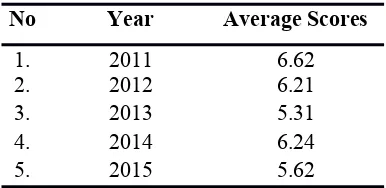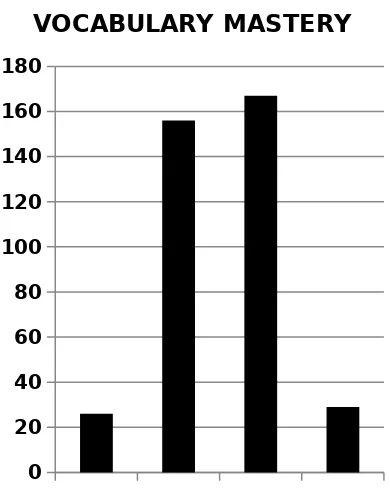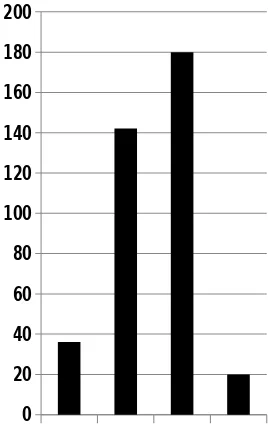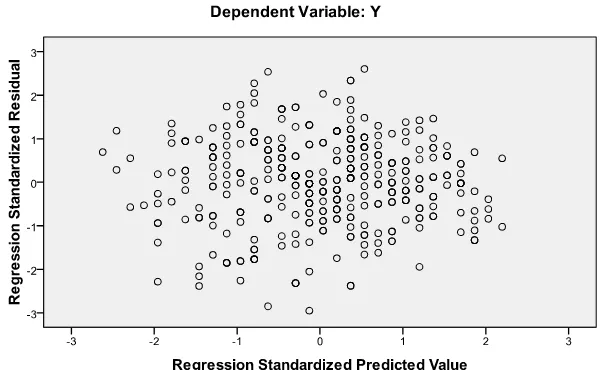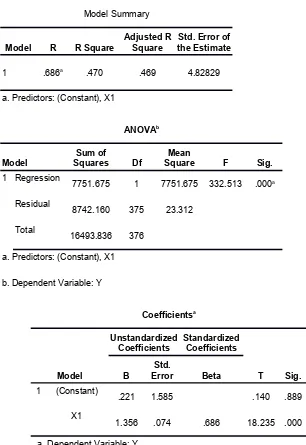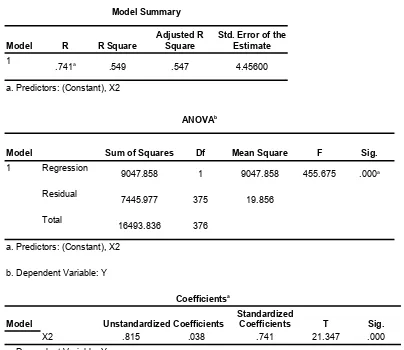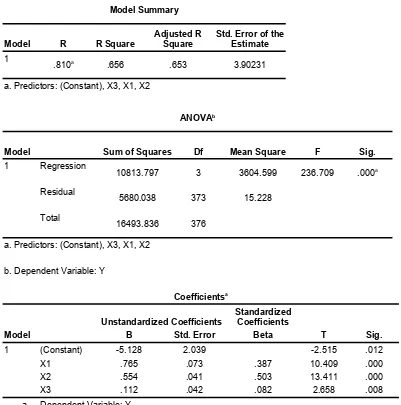THE INFLUENCE OF HIGHER ORDER THINKING SKILLS, VOCABULARY MASTERY AND READING MOTIVATION
ON READING COMPREHENSION ACHIEVEMENT Titik Sholihah, Agus Widyantoro
SMP N 1 Muntilan, Yogyakarta State University titiksholihah@gmail.com, agus_wiwied@yahoo.com
ABSTRACT
This research aims at finding out the influence of Higher Order Thinking Skills (HOTSs), vocabulary mastery and reading motivation on reading comprehension achievement among State SMP Students in Magelang Regency. This research was an ex post facto involving three independent variables; students’ HOTSs (X1), vocabulary mastery (X2), and reading motivation (X3) and one dependent variable, students’ reading comprehension achievement (Y). The sampling technique was the proportional cluster random sampling. The research instruments were three tests and a questionnaire. The kind of validity of the tests was the content validity by experts’ judgment. The construct validity of the questionnaire was measured by factor analysis. The reliability of the tests was measured by Cronbach’s Alpha with the Alpha of HOTSs test is 0.768, vocabulary mastery test’s is 0.757 and the reading comprehension achievement test’s is 0.716. The reliability of the questionnaire was measured by Cronbach’s Alpha with the Alpha is 0.862. The data were analyzed using the multiple regression analysis continued by the partial correlation. The result of the multiple regressions indicates that HOTSs, vocabulary mastery and reading motivation influence reading comprehension achievement with the F=236.709 with the significant level below 0.05 which means that the three independent variables influence significantly on reading comprehension achievement. The Adjusted R Square is 0.653 which means that the reading comprehension achievement is 65.3 % predicted by the three independent variables. The contribution of HOTSs on reading comprehension achievement is 38.7%, vocabulary mastery is 50.3%, and reading motivation is 8.2%.
PENGARUH HIGHER ORDER THINKING SKILLS, PENGUASAAN KOSAKATA
DAN MOTIVASI MEMBACA TERHADAP PRESTASI MEMBACA
Titik Sholihah, Agus Widyantoro
SMP N 1 Muntilan, Universitas Negeri Yogyakarta titiksholihah@gmail.com, agus_wiwied@yahoo.com
ABSTRAK
Penelitian ini bertujuan untuk membuktikan pengaruh
Higher Order Thinking Skills
,
Penguasaan Kosakata dan Motivasi Membaca terhadap Prestasi Membaca Siswa
SMP Negeri
di Kabupaten Magelang. Jenis penelitian ini adalah
ex post facto
, dengan tiga variabel terikat;
HOTSs
(X1), penguasaan kosakata (X2), motivasi membaca (X3) dan satu variabel bebas;
kemampuan pemahaman bacaan (Y). Teknik pengambilan sampel berupa teknik
proportional
cluster random sampling
. Instrument penelitian adalah tes dan angket. Validitas intrumen tes
adalah validitas isi dengan
expert judgement
. Validitas konstruk angket diukur dengan
analisis faktor. Reliabilitas tes diukur dengan Alpha
Cronbach dengan nilai Alpha tes
HOTSs
sebesar 0,768, tes penguasaan kosakata 0,757 dan tes kompetensi pemahaman bacaan 0,716.
Reliabilitas angket dihitung dengan Alpha Cronbach dengan nilai Alpha sebesar 0,862. Data
penelitian dianalisis dengan teknik Regresi Ganda dilanjutkan dengan Korelasi Parsial. Hasil
uji Regresi Ganda menunjukkan bahwa
HOTSs
, penguasaan kosakata dan motivasi membaca
secara bersama-sama berpengaruh terhadap kompetensi pemahaman bacaan dengan nilai F =
236.709 dengan taraf signifikansi di bawah 0.05 yang berarti bahwa ketiga variabel bebas
mempengaruhi variabel terikat secara signifikan. Nilai
Adjusted R Square
sebesar 0.653
yang berarti bahwa prestasi membaca dapat diprediksi oleh ketiga variabel bebas sebesar
65.3%. Peran
HOTSs
terhadap kompetensi pemahaman bacaan sebesar 38,7%, penguasaan
kosakata 50,3%, dan motivasi membaca is 8,2%.
Kata kunci:
Higher Order Thinking Skills
(
HOTSs
),
penguasaan kosakata, motivasi
membaca, prestasi membaca
Reading is an activity that cannot be separated from the daily activities to get the abundant information from both printed and electronic media. In this global era, information spreads rapidly through internet that requires reading. This provides evidence that reading is a must. For school students, this turns out to be very crucial. Therefore, reading should be developed well from the early time. In the Indonesian education context, reading is one of the essential competencies that has a close relation to every subject at school. Outside school context, the information provided in the internet is frequently written in English, too. Therefore reading requires good English mastery as well.
In the history of English Language Teaching in Indonesia, reading receives plenty of attention. Even, in English for Specific Purposes trainings, the development of reading skills among the participants receives lots of attention (Sugirin, 2013, p. 9). Koda and Zehler in Sugirin (2013, p. 9) stated that failure to obtain sufficient reading proficiency obstructs students to access the important tool for further learning. Reading skills definitely do not guarantee one person’s success, however success will difficult to achieve without being a skilled reader (Grabe 2009, p. 5).
Recently, to enhance the English skills, Indonesian schools give more attention to provide more opportunities to use English. In addition, the items in the National Examination 88% are on reading tests and only 12% are in the form of writing tests. Moreover, the trend of the last two years recently of the National Examination items types moves to higher order thinking items. These items refer to Bloom’s Taxonomy level C4, C5, and C6 referring the achievements of analyzing, evaluating and creating. The importance of developing higher order thinking skills is also related with the latest curriculum 2013 which uses Scientific Approach. This approach aims at developing students’ critical thinking which is in line with the higher order thinking skills. Thus to keep up with the trend of the new curriculum, it is
necessary for teachers to develop students’ higher order thinking skills.
In reading new texts, students may find some new vocabulary items. Some of them may be reluctant to find the meaning of the new words that could disturb their comprehension. Therefore, the excellent vocabulary mastery is extremely needed in comprehending an English text. To understand a reading text, it requires an adequate mastery of vocabulary and an excellent comprehension of the English grammar as well. This can be achieved only by those who have high motivation to read English texts. Therefore teachers need to raise students’ motivation to read lots of English materials, both inside and outside classes. Students need to be motivated to develop their extensive reading skills or to read materials that are not intended to discuss inside classes.
Based on the writer’s observation on the result of the National Examination of Junior High School (SMP), particularly in Magelang Regency, the English National Exam scores in the last four years were only around 6 as provided in the following table.
Table 1. The Result of the English National Examination Scores of Junior High School in
Magelang Regency
Source: Balitbang, Hasil UN
This condition is in accordance with the research conducted by Romafi & Musfiroh (2015, p. 9) which revealed the fact that the state SMP students in Brebes Regency in 2013 possess considerably low reading comprehension achievement with the average scores 4.35.
X2
Research Design and Setting
This research is intended to find out
the influence of Higher Order Thinking
Skills, vocabulary mastery and motivation
on reading comprehension achievement
among SMP students in Magelang
Regency. In accordance with the purpose
of the research, the research design is ex
post facto. In this research, there is no
treatment carried out to the sample.
There are three independent
variables in this research; students’ HOTS
as X1, vocabulary mastery as X2, and
reading motivation as X3. The dependent
variable is students’ reading
comprehension achievement as Y.
The research design could be
illustrated in the picture below:
r123
X2
=
vocabulary mastery
X3
=
motivation
Y
=
reading comprehension
achievement
The research was carried out in State SMP (Junior High Schools) in Magelang Regency from October to November 2014.
Population and Sample
With the total population of 25,261, by referring to the formula of determining the number of samples developed by Krejcie and
Morgan yields the number of sample 378. The population in this research is grade IX the students in State Junior High Schools in Magelang Regency. The sampling technique employed in this research is the proportional cluster random sampling. By using random sampling, there are 3 (three) schools chosen as samples of A-Accredited schools; SMP N 1 Salaman, SMP N 1 Mungkid, and SMP N 2 Muntilan. And for the B-Accredited schools SMP N 3 Sawangan is chosen as the school sample.
Data Collection Techniques and Instruments The technique to collect the data on students HOTSs, vocabulary mastery and reading comprehension achievement is the test. To find out students’ motivation, the data collection technique used is the questionnaire in the form of some questions related to their motivation to read. Those tests are in the form of multiple choice tests. To test HOTSs, the students have to answer some questions that refer to their skills to analyze, evaluate and create based on the reading texts provided. In the vocabulary mastery test, the students have to answer some cloze test to fill in with appropriate words. The other type of the test items are the synonym and the antonym based on the reading texts used as the material to test reading comprehension achievement. To test students’ reading comprehension achievement, the students will get some reading texts followed by some questions related to the texts.
To collect the data on students’ HOTSs (X1), vocabulary mastery (X2), and reading motivation (X3) and reading comprehension achievement (Y), the first step to do is constructing the table of specifications. To find out whether the data collection instruments match or relevant with the variables and the research problems, it is important to test its validity and reliability before they are used. The kinds of validity of the tests are the content validity. The content of the tests instruments is based on the KTSP curriculum and Achievement Standard of Outcomes (SKL) and also is consulted with the expert or expert judgment. To test the validity of the questionnaire, the construct validity is employed in the form of factor analysis..
The try out data collection of the questionnaire was conducted on 47 students of class IXE and IXF of SMP N 1 Muntilan, out
X3
of the sample schools and classes. The result of the factor analysis shows the value of KMO 0.632 with the significance level 0.000. This means that the value of KMO is bigger than 0.5 and the significance level is also less than 0.5. Therefore, the factor analysis was filled and the questionnaire could be stated as valid.
The try-out tests on HOTSs, vocabulary mastery and reading comprehension achievement were carried out on 47 students of class IXE and IXF in SMP N 1 Muntilan, out of the sample schools and classes. The Alpha of HOTSS test is 0.768, that of vocabulary mastery is 0.757 and that of reading comprehension achievement is 0.716. These figures indicate that those three tests could be utilized in the research.
The try out test on HOTSs was carried out on 47 students of class IXE and IXF of SMP N 1 Muntilan. The test comprises 40 (82%) were reliable and the rest 9 (18%) were rejected. The try out test on reading comprehension achievement was carried out on 47 students of class IXE and IXF of SMP N 1 Muntilan. The test comprises 50 items, 43 items (86%) were reliable and the rest 7 items (14%) were rejected.
To test the reliability of the questionnaire, the research employs the Cronbach’s Alpha with the minimum difficulty index 0.5. The try out test was conducted by 47 students of class IXE and IXF of SMP N 1 Muntilan. The reliability was done by factor analysis by SPSS version 16 for Windows program which results the Alpha 0.862. This value indicates that the instrument could be used in collecting data of the research.
Data Analysis Techniques
There are two main steps needed to analyze the data in this research; (1) the test of analysis prerequisites and (2) the data analysis. To analyze the data employing multiple regression analysis, it is important to conduct a test of analysis prerequisites in the form of the test of normality, the test of linearity, the test
of multicolinearity and the test of heteroscedasticity
To find out the normality, this research employs One-Sample Kolmogorov-Smirnow. The linearity is tested by using Compared Means with test of Linearity. The test of multicolinearity aims to test whether in the regression analysis there are some correlations among the independent variables. To find out the heteroscedasticity this research, the scatter plotting of SRESID and ZPRED is employed to test the heteroscedasticicty.
Data Analysis
This research would employ descriptive analysis, multiple regression and partial correlation. The descriptive analysis aims to describe each variable of the research. in terms of maximum and minimum scores, mean, standard deviation, mode and median.
The multiple regression analysis is employed to find out the influences of more than one independent variable to one dependent variable. To predict the value of the dependent variable (Y) based on the independent variables (X1), (X2), and (X3) from the multiple regression can be drawn the multiple regression equation. The partial correlation is the correlation between one independent variable with the dependent variable which has a constant value.
Research Findings and Discussion Data Description
Data description in this research covers data description on Higher Order Thinking Skills (HOTSs), vocabulary mastery, reading motivation and reading comprehension achievement on English texts. The number of samples employed in this research is 378 students doing on HOTSs test of 36 items, vocabulary test of 41 items, reading motivation questionnaire of 15 items and reading comprehension test of 50 items.
Higher Order Thinking Skills Data Description
the minimum one is 11, the average score is 21.3439 and the standard deviation is 3.52155. The data
of Higher Order Thinking Skills of
the students fall into “
fair
” in the majority
as seen in Figure 1 as follows:
0 20 40 60 80 100 120 140 160 180 200
HIGHER ORDER THINKING SKILLS
Figure 1. HOTSs Scores Column Chart
Vocabluary Mastery Data Description
The research finding on vocabulary mastery the maximum score is 37 and the minimum one is 8, the average score is 23.7540 and the standard deviation is 6.02649. The data
of Vocabulary Mastery of the
students fall into “
fair
” in the majority
as seen in Figure 2 as follows:0 20 40 60 80 100 120 140 160 180
VOCABULARY MASTERY
Figure 2. Vocabulary mastery Scores Column Chart
Reading Motivation Data Description
The 15-items of 60 maximum scores from a reading motivation test result the maximum score is 55 and the minimum score is 24, and the average score is 41.2249 with the standard deviation of 4.85435. The data
of
Reading Motivation of the students fall
into “
medium
” in the majority
as seen in Figure 3 as follows:0 50 100 150 200 250
READING MOTIVATION
Reading Comprehension Achievement Data Description
The research findings on reading comprehension achievement are that out of 50 items the maximum score is 43 and the minimum score is 9, the average score is 28.7963 and the standard deviation is 6.62791. The data
of Reading Comprehension
normal or not. The normality test is carried out for each variable which results there are two variables which are not normally distributed; these are Higher Order Thinking Skills and Reading Motivation with the significance levels are less than 0.05.From the initial data analysis, there is one outlier detected. An outlier is a datum that lies in an extreme position from the other data that has to be excluded from the research model. The outlier is the 34th datum so that the datum has to beexpelled from this research. Therefore, the number of sample reduces to 377.
After the removal of the outlier, the normality of each variable by employing the same test reveals that the reading comprehension achievement scores have the level of significance 0.198 which is greater than 0.05.
The test of linearity is carried out to find out the linearity of the relationship among the independent variables and the dependent one. The principle of the test of linearity is that if the ANOVA analysis yields the p value from the deviation of linearity which is greater than 0.05. If this happens, it means that the relationship between the two variables is linear. If the p value is smaller than 0.05, the relationship between the two variables is not linear.
The test of linearity on HOTSs and Reading Comprehension Achievement yields the level of significance 0.105 which is greater than 0.05 which shows that there is a significant linear relationship between the two variables. The test of linearity on vocabulary mastery and reading comprehension achievement yields the level of significance 0.98 which is greater than 0.05 which shows that there is a significant linear relationship between the two variables. The test of linearity on reading motivation and reading comprehension achievement produces the level of significance is 0.260 which is greater than 0.05 which shows that there is a significant linear relationship between the two variables.
Test of multicolinearity is carried out by employing the value of variance inflation factor (VIF). The data is considered free from the multicolinearity if the VIF value is below 10 or the tolerance level if greater than 0.1. Below is the result of the multicolinearity in this research.The result of the multicolinearity analysis in this research shows that all the VIF values 1.495, 1.526, 1.033 which below 10 or the tolerance values are above 0.1. This means that there is no multicolinearity in this research data.
which show heteroscedasticity indication by finding out certain pattern in the graphics. The result of the test of heteroscedasticity in this research in this research can be seen in the following Figure 5.
In Figure 5, it can be seen that in this research there is no heteroscedasticity since there is no certain pattern in the figure. The dots in the graphics are relatively scattered above and below the null axis. This means that
there is no heteroscedasticity indication between Vocabulary Mastery and Reading Comprehension Achievement. The same indications also happen on HOTSs and Reading Comprehension Achievement and Reading Motivation and Reading Comprehension Achievement. There are no heteroscedasticity indication on those variables.
.
Figure 5. Test of Heteroscedasticity on Vocabulary Mastery and Reading Comprehension Achievement
The Hypotheses Testing
The F test (simultaneous) and the T test (partial) are conducted before testing the hypotheses. The F test is carried out to find out the influence of the independent variables on the dependent variable simultaneously. The F Test (simultaneous) yields the F value in the analysis is 236.709 with the level of significance below 0.05. This means that all independent variables simultaneously influence significantly on the reading comprehension achievement with the level of significant 0.05. Based on the model summary, the determination coefficient (R square) is 0.656. This means all the independent variables simultaneously influence reading comprehension achievement at 65.6% and the
rest 34.4% is influenced by other variables which are not included in this research.
The T test is carried out to find out the influence of each independent variable on reading comprehension achievement. The result of the analysis of the t-value produces the multiple regression linear equations as follows:
Y = 0.765X1 + 0.554X2 + 0.112X3 – 5.128 in which
Y = Reading Comprehension Achievement X1= HOTSs
Hypotheses Testing Hypothesis 1:
There is the influence of Higher Order Thinking Skills (HOTSs) on reading comprehension achievement among grade IX students of State Junior High School in Magelang Regency.
Decision
If the observed level of significance is below 0.05 the Ho is rejected. This means that the independent variable possesses positive influence on the dependent variable. To find out the influence of HOTSs on reading comprehension achievement the research employs a simple linear regression model as follows:
Table 2. The Result of the Simple Linear Regression
Model Summary
Model R R Square
Adjusted R Square
Std. Error of the Estimate
1 .686a .470 .469 4.82829
a. Predictors: (Constant), X1
ANOVAb
Model
Sum of
Squares Df
Mean
Square F Sig.
1 Regression
7751.675 1 7751.675 332.513 .000a
Residual
8742.160 375 23.312
Total
16493.836 376
a. Predictors: (Constant), X1
b. Dependent Variable: Y
Coefficientsa
Model
Unstandardized
Coefficients StandardizedCoefficients
T Sig.
B ErrorStd. Beta
1 (Constant)
.221 1.585 .140 .889
X1
1.356 .074 .686 18.235 .000
a. Dependent Variable: Y
From Table 2, the value of F is 332.513 with the significance level of 0.000 which is less than 0.05. This shows that the
coefficient (Adjusted R Square) is 0.469 or 46.9 % which means that the HOTSs are able to predict the reading comprehension achievement at 46.9%. In other words the reading comprehension achievement of grade IX students of State Junior High School in Magelang Regency could be explained by their HOTSs at 46.9%.From the standardized coefficients beta, the contribution of HOTSs on reading comprehension is 68.6%. The partial correlation between HOTSs and reading comprehension achievement results the level of significance (sig) which is less than 0.05.
The result of the partial correlation shows the value of r is 0.686 with the p < 0.05 which means that HOTSs influences significantly on reading comprehension achievement. Therefore it can be concluded that HOTSs as a variable has a positive and significant influence on the reading comprehension achievement.
Hypothesis 2:
There is the influence of vocabulary mastery on reading comprehension achievement among grade IX students of State Junior High School in Magelang Regency.
Decision
If the observed level of significance is below 0.05 the Ho is rejected. This means that the independent variable possesses positive influence on the dependent variable. To find out the influence of vocabulary mastery on reading comprehension achievement the research employs simple linear regression model as seen in Table 3 as follows:
Table 3. The Result of the Simple Linear Regression
Model Summary
Model R R Square Adjusted RSquare Std. Error of theEstimate
1
.741a .549 .547 4.45600
a. Predictors: (Constant), X2
ANOVAb
Model Sum of Squares Df Mean Square F Sig.
1 Regression
9047.858 1 9047.858 455.675 .000a
Residual
7445.977 375 19.856
Total
16493.836 376
a. Predictors: (Constant), X2
b. Dependent Variable: Y
Coefficientsa
Model
Unstandardized Coefficients
Standardized Coefficients
T Sig.
B Std. Error Beta
Model Summary
Model R R Square
Adjusted R Square
Std. Error of the Estimate 1
.741a .549 .547 4.45600
a. Predictors: (Constant), X2
ANOVAb
Model Sum of Squares Df Mean Square F Sig.
1 Regression
9047.858 1 9047.858 455.675 .000a
Residual
7445.977 375 19.856
Total
16493.836 376
a. Predictors: (Constant), X2
b. Dependent Variable: Y
Coefficientsa
Model Unstandardized Coefficients StandardizedCoefficients T Sig.
X2 .815 .038 .741 21.347 .000
a. Dependent Variable: Y
From Table 3, the value of F is 455.675 with the significance level of 0.000 which is less than 0.05. This shows that vocabulary mastery influences students’ reading comprehension achievement. The observed determination coefficient (Adjusted R Square) is 0.547. This means that vocabulary is able to predict the reading comprehension achievement at 54.7%. In other words the reading comprehension achievement of grade IX students of State Junior High School in Magelang Regency could be explained by vocabulary mastery and reading motivation at 54.7%. From the standardized coefficients beta, the contribution of vocabulary mastery on reading comprehension achievement is 74.1%.
The result of the partial correlation shows the value of r 0.741 with the p less than 0.05 which means that the vocabulary mastery influences reading comprehension achievement significantly. Therefore the
summary is that the vocabulary mastery has a positive and significant influence on reading comprehension achievement.
Hypothesis 3:
There is the influence of reading motivation on reading comprehension achievement among grade IX students of State Junior High School in Magelang Regency.
Decision
If the observed level of significance is below 0.05 the Ho is rejected. This means than the independent variable has a positive influence on the dependent variable. To find out the influence of reading motivation on reading comprehension achievement the research employs simple linear regression model as seen in the following table
Model Summary
Model R R Square
Adjusted R Square
Std. Error of the Estimate 1
.215a .046 .044 6.47658
a. Predictors: (Constant), X3
ANOVAb
Model Sum of Squares Df Mean Square F Sig.
1 Regression
764.059 1 764.059 18.215 .000a
Residual
15729.776 375 41.946
Total
16493.836 376
a. Predictors: (Constant), X3
b. Dependent Variable: Y
Coefficientsa
Model
Unstandardized Coefficients StandardizedCoefficients
T Sig.
B Std. Error Beta
1 (Constant) 16.659 2.858 5.828 .000
X3 .294 .069 .215 4.268 .000
a. Dependent Variable: Y
From Table 4, the value of F is 18.215 with the significance level of 0.000 which is less than 0.05. This means that the reading motivation possesses significant influence on reading comprehension achievement. The observed determination coefficient (Adjusted R Square) is 0.44. This means that reading motivation is able to predict the reading comprehension achievement at 44%. In other words the reading comprehension achievement of grade IX students of State Junior High School in Magelang Regency could be explained by their reading motivation at 44%. From the standardized coefficients beta, the contribution of reading motivation on reading comprehension is 21.5%.
The result of partial correlation shows the r 0.215 with the p is less than 0.05 which means that reading motivation influences reading comprehension achievement significantly. Therefore the conclusion is that the reading motivation has a positive and significant influence on reading comprehension achievement.
Hypothesis 4:
There are the influences of higher order thinking skills (HOTSS), vocabulary mastery and reading motivation on reading comprehension achievement among grade IX students of State Junior High School in Magelang Regency.
Decision
Table 5. The Result of the Multiple Regression
Model Summary
Model R R Square
Adjusted R Square
Std. Error of the Estimate 1
.810a .656 .653 3.90231
a. Predictors: (Constant), X3, X1, X2
ANOVAb
Model Sum of Squares Df Mean Square F Sig.
1 Regression
10813.797 3 3604.599 236.709 .000a
Residual
5680.038 373 15.228
Total
16493.836 376
a. Predictors: (Constant), X3, X1, X2
b. Dependent Variable: Y
Coefficientsa
Model
Unstandardized Coefficients StandardizedCoefficients
T Sig.
B Std. Error Beta
1 (Constant) -5.128 2.039 -2.515 .012
X1 .765 .073 .387 10.409 .000
X2 .554 .041 .503 13.411 .000
X3 .112 .042 .082 2.658 .008
a. Dependent Variable: Y
From Table 5, the value of F is 236.709 with the significance level of 0.000 which is less than 0.05. This shows that the Higher Order Thinking Skills, vocabulary mastery and reading motivation influence students’ reading comprehension achievement. The observed determination coefficient (Adjusted R Square) is 0.653 or 65.3%. This means that the HOTSs, vocabulary mastery and reading motivation simultaneously are able to predict the reading comprehension achievement at 65.3%. In other words the reading comprehension achievement of grade
correlations tests are shown in the following table.
The correlation coefficient index between HOTSs and reading comprehension achievement is 0.686 with the p less than 0.05. The correlation index between vocabulary mastery and reading comprehension achievement is 0.741 with the p smaller than 0.05. The correlation index between reading motivation and reading comprehension achievement is 0.215 with the p less than 0.05. The correlation coefficient index between vocabulary mastery and reading comprehension achievement is the highest compared to correlation coefficient between HOTSs and reading comprehension achievement and correlation coefficient between reading motivation and reading comprehension achievement (0.741 > 0.686 > 0.215).
The Discussion on Research Findings
The Influence of Higher Order Thinking Skills (HOTSs) on Reading Comprehension Achievement Among Students of State Junior High School in Magelang Regency.
The partial correlation analysis shows that the correlation coefficient (r) between the Higher Order Thinking Skills and reading comprehension achievement is 0.686 with the p < 0.05. The strong relation between the value of t in simple regression analysis. The observed determination coefficient (Adjusted R Square) is 0.469 which means the reading comprehension achievement of grade IX students of State Junior High School in Magelang Regency could be explained by their HOTSs at 46.9%. The Higher Order Thinking Skills give 68.6% contribution on reading (2007, p. 4) that is “at more global levels, the reader needs to identify the genre, rhetorical
structure, plot, and perspective of different characters, narrator, theme, story point, and sometimes the attitude of the author”. McNamara (2007, p. 4) further stated that deep comprehension requires inferences, linking ideas coherently, scrutinizing the validity of claims with a critical stance, and sometimes understanding the motives of authors. They need to acquire and implement strategies to facilitate deeper levels of comprehension.
The Influence of Vocabulary Mastery on Reading Comprehension Achievement among Students of State Junior High School in Magelang Regency.
The partial correlation analysis shows that the correlation coefficient (r) between the vocabulary mastery and reading comprehension achievement is 0.741 with the p < 0.05. The strong relation between the vocabulary mastery and reading comprehension achievement is supported by the strong influence of the vocabulary mastery on reading comprehension achievement that is 21.347 gained from the value of t in simple linear regression analysis. The observed determination coefficient (Adjusted R Square) is 0.547 which means the reading comprehension achievement of grade IX students of State Junior High School in Magelang Regency could be explained by vocabulary mastery and reading motivation at 54.7%.
The vocabulary mastery gives great contribution on reading comprehension achievement. The multiple regression analysis produces standardized coefficients beta 0.741. This figure indicates that vocabulary mastery give contribution at 74.1% on reading comprehension achievement. This data show that to obtain an excellent reading comprehension achievement the students have to develop their vocabulary mastery. This finding is supported by the statement of an expert as well. The minimum important requirement that a reader should have to comprehend a text is their comprehension on the words used by the author (Zuchdi, 2008, p. 29).
Students of State Junior High School in Magelang Regency.
The partial correlation analysis shows that the correlation coefficient (r) between the reading motivation and reading comprehension achievement is 0.215 with the p < 0.05. This shows the relation is positive although not significant. The relation between the reading motivation and reading comprehension achievement is supported by the influence of the reading motivation on reading comprehension achievement that is 4.268 gained from the value of t in simple linear regression analysis. The observed determination coefficient (Adjusted R Square) is 0.44 which means that the reading comprehension achievement of grade IX students of State Junior High School in Magelang Regency could be explained by their reading motivation at 44%. The reading motivation gives a relatively small contribution on reading comprehension achievement. The multiple regression analysis produces standardized coefficients beta 0.215. This figure indicates that reading motivation give contribution at 21.5% on reading comprehension achievement.
This data shows that to obtain an excellent reading comprehension achievement the students have to raise their reading motivation. This finding is supported by the statement of an expert as well. If the students are not motivated to learn to read and write, instruction will have limited impact (Scanlon, Anderson & Sweeney, 2010, p. 50).
The Influences of Higher Order Thinking Skills (HOTSs), Vocabulary Mastery and Reading Motivation on Reading Comprehension Achievement among Students Of State Junior High School in Magelang Regency.
The PISA English test types are in the form of reading which adopts the High Oder Thinking Skills; the most three upper part in Bloom’s
Taxonomy. Higher Order Thinking Skills are basically related to the critical thinking. The implementation of critical thinking in tests is on measuring the higher order thinking skills which refer to Bloom’s Taxonomy C4, C5 and C6. To communicate adequately, someone needs adequate vocabulary mastery, too. If communication takes place via written language, vocabulary, therefore, becomes one of the important things to comprehend certain text. Reading motivation is another consideration in reading activity. If the students do not motivate themselves to read to teaching instruction inside the classroom does not work well. The Higher Order Thinking Skills, vocabulary mastery and reading motivation are some factors that influence reading comprehension achievement. The bounds among those three factors are proven in this research, which had been carried out on the Grade IX students in State SMP in Magelang Regency. This research does not only reveal the relationship but also uncover the significant and positive influence among The Higher Order Thinking Skills, vocabulary mastery and reading motivation on reading comprehension achievement through multiple regression analysis.
motivation and reading comprehension achievement is not significant.
Those positive and significant relationships indicate that both independent variables and the dependent variable influence each other. It means that if students have excellent Higher Order Thinking Skills, vocabulary mastery and reading motivation, they will gain fine reading comprehension achievement as well. On the contrary, if they have poor Higher Order Thinking Skills, vocabulary mastery and reading motivation, they will gain low reading comprehension achievement, too.
The multiple regression analysis yields the F reg 236.709with the p < 0.05. This figures point out that the Higher Order Thinking Skills, vocabulary mastery and reading motivation have significant influence on Grade IX State SMP students in Magelang Regency’s reading comprehension achievement. The strong influence of the Higher Order Thinking Skills, vocabulary mastery and reading motivation on reading comprehension achievement is supported by the value of Adjusted R Square at 65.3%. Moreover, the standardized coefficients beta of the Higher Order Thinking Skills shows that the influences of the three independent variables are vocabulary mastery (50.3%) has bigger influence than the Higher Order Thinking Skills (38.7%) which has bigger influence McNamara (2007, p. 4) who stated that the reader needs to identify the genre, rhetorical structure, plot, and perspective of different characters, narrator, theme, story point, and sometimes the attitude of the author. They need to acquire and implement strategies to facilitate deeper levels of comprehension. Vocabulary mastery is also highly needed in reading activity.
Richards and Renandya (2002, p. 267) stated that reading has long been seen as a major source of vocabulary growth. Reading motivation is another thing to consider in reading. If the students do not motivate themselves to read and to write the teaching instruction will have low impact (Scanlon, Anderson & Sweeney, 2010, p. 50).
Conclusion and Suggestions Conclusion
Based on the data and the discussion, the conclusion of this research could be stated that, first, Higher Order Thinking Skills (HOTSs) is related to reading comprehension achievement among students of State Junior High School in Magelang Regency with the r = 0.686 with the p < 0.05. HOTSS could predict reading comprehension achievement at 46.9%. The contribution of HOTSS is 68.6% on reading comprehension achievement.
Secondly, vocabulary mastery is related to reading comprehension achievement among students of State Junior High School in Magelang Regency with the r = 0.741 with the p < 0.05. The vocabulary mastery could predict reading comprehension achievement at 54.7%. The contribution of vocabulary mastery on reading comprehension achievement is 74.1%.
motivation 8.2%. The rest 2.8% is from other variables which are not observed in this research.
Suggestions
Despite its limitation, this research is ideally to give some contribution to the follow up study with certainly some revisions. The suggestion of this research could be, first, teachers are to enhance students’ Higher Order Thinking Skills (s) since it could improve their students’ reading comprehension achievement.
Secondly, teachers and students, collaboratively, are to increase students’ vocabulary mastery since this factor could raise their reading comprehension achievement.
Thirdly, both teachers and students are to improve students’ reading motivation since it could raise students’ reading comprehension achievement.
Fourthly, teachers and students are to enhance students’ Higher Order Thinking skills (HOTSs), vocabulary mastery and reading motivation since those three factors
could improve their reading comprehension achievement.
References
Grabe, W.(2009). Reading in second language. New York: Cambridge University Press.
McNamara, D.S. (2007). Reading comprehension strategies. New Jersey: Lawrence Erlbaum Associates, Inc. Richards, J.C. & Renandya, W. A. (2002).
Methodology in language teaching.
Cambridge: Cambridge University Press.
Romafi, R., Musfiroh, T.. Hubungan minat membaca, fasilitas orang tua, dan pemberian tugas membaca dengan kemampuan membaca pemahaman siswa. LingTera, North America, 2, oct. 2015. Available at: <http://journal.uny.ac.id/index.php/ljtp /article/view/7377/6378>. Date accessed: 14 Dec. 2015.
Scanlon, D.M., Anderson, K.L. & Sweeney, J.M., (2010). Early inventions for reading difficulties. New York: The Guilford Press.
Sugirin (2013). Hakikat reading dan implikasinya bagi pembelajaran. Unpublished Professorship Speech. Yogyakarta: UNY.
Zuchdi, D. (2008). Strategi meningkatkan kemampuan membaca. Yogyakarta: UNY Press.
Writers’ Profile
Titik Sholihah was born in Magelang, 24th November, 1974. She finished her under graduate education in English Education Department of IKIP Yogyakarta in 1999. She teaches English in SMP N 1 Muntilan, Magelang Regency up to now.
Agus Widyantoro was born in Bantul, 8th March, 1960. He finished his under graduate education in English Education Department of IKIP Yogyakarta in 1984. He continued his
